Top Language Learning Activities in English Language Lab Software

- To properly understand a language, students must go beyond textbook tutorials and assignments that require writing and actively participate in speaking, practising conversations, and watching real-life interactions, whether watching videos or interactions with native speakers.
- Our Digital Teacher-English Language Lab software provides practical learning tools that include real-life experiences and engage students in real-language usage. Students can engage in conversations, interactive activities, & images to improve their understanding and use of the English language. This method is generally useful since it enhances communication skills and increases confidence at any age.
- The discussion below looks into the different language learning exercises supported by this software, which helps to improve students’ LSRW Key Activities (Listening, Speaking, Reading, and Writing) skills. In addition, there are soft and life skills. Phonetics…
Key Activities in English Language Lab Software – Digital Teacher
Our Language Lab software includes a variety of activities designed to improve skills in the English language. These activities focus on many aspects of language learning, allowing for overall growth in listening, speaking, reading, writing, grammar, and vocabulary.
An outline of the top 4 activities is provided below:
| Activity Type | Benefits of Activity |
|---|---|
| Listening Activities (L) | Fun exercises that include listening to dialogues, audio recordings, and more. |
| Speaking Activities (S) | Involve practice activities for oral communication, such as speeches and conversations. |
| Reading Activities (R) | Include comprehension activities, summarizing books, and discussing paragraphs. |
| Writing Activities (W) | Cover paragraph writing, essay writing, and grammar exercises. |
In addition, the syllabus contains specialist modules focusing on phonetics for proper pronunciation, as well as activities designed for developing Grammar and Vocabulary, soft and life skills.
| Activity Type | Benefits of Activity |
|---|---|
| Grammar and Vocabulary | Activities to improve grammar rules, sentence structure, and vocabulary. |
| Phonetics | Phonetic learning exercises help to enhance speech accuracy and comprehension of phonetic symbols. |
| Soft Skills | The sections are constructed to improve interpersonal skills, communication, and teamwork. |
| Life Skills | Activities that concentrate on practical skills such as problem-solving, time management, etc. |
The table in the design above allows the activities that the English Language Lab software offers to be displayed in a simple and structured method. Now, I will explain each of these exercises in detail.
Language Learning Activity-1: Listening Skills (L)
Language learning starts with listening skills. Several types of listening activities, such as dialogues, podcasts, and audio recordings, are available in the content.
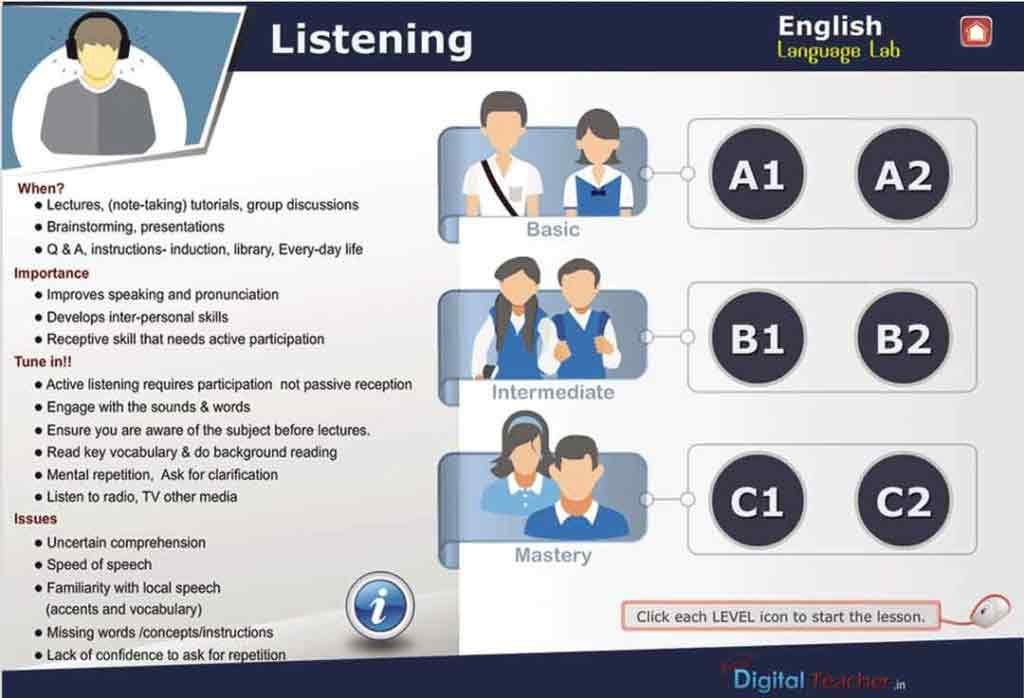
- Importance of Listening Skills:
- Listening enhances speech and pronunciation skill sets.
- Improves interpersonal skills by highlighting how to listen properly.
- Levels and Sections:
- The course is divided into three levels:
- Basic (A1),
- Intermediate (A2, B1), and
- Mastery (B2, C1, C2).
- Each level contains units with various activities like listening to phrases, understanding conversations, and more.
- Activities of: (Listening Skills)
- Activities include listening to audio and identifying letters/words.
- There are picture-based exercises in which participants choose the appropriate image based on sound guidance.
- Story-based activities need listening and answering questions about the topic.
- The assessment section offers timed exercises to measure understanding and progress.
- Navigation & Features:
- Participants get between activities by using buttons such as next, previous, replay, and home.
- Progress may be tracked and results examined to identify areas for improvement.
- These points reflect the usefulness and instructional value of the software’s Listening Skills component.
Bonus Tips for Improving Listening Skills:
Try our free “language lab demo” to experience how it can improve your student’s English listening skills.
Language Learning Activity-2: Speaking Activities (S)
Understanding the vocabulary, fluency, and pronunciation of the language are all necessary speaking abilities. To enhance the way you speak, practice speaking English every day, take part in English activities such as lessons or courses, and listen to native English speakers.
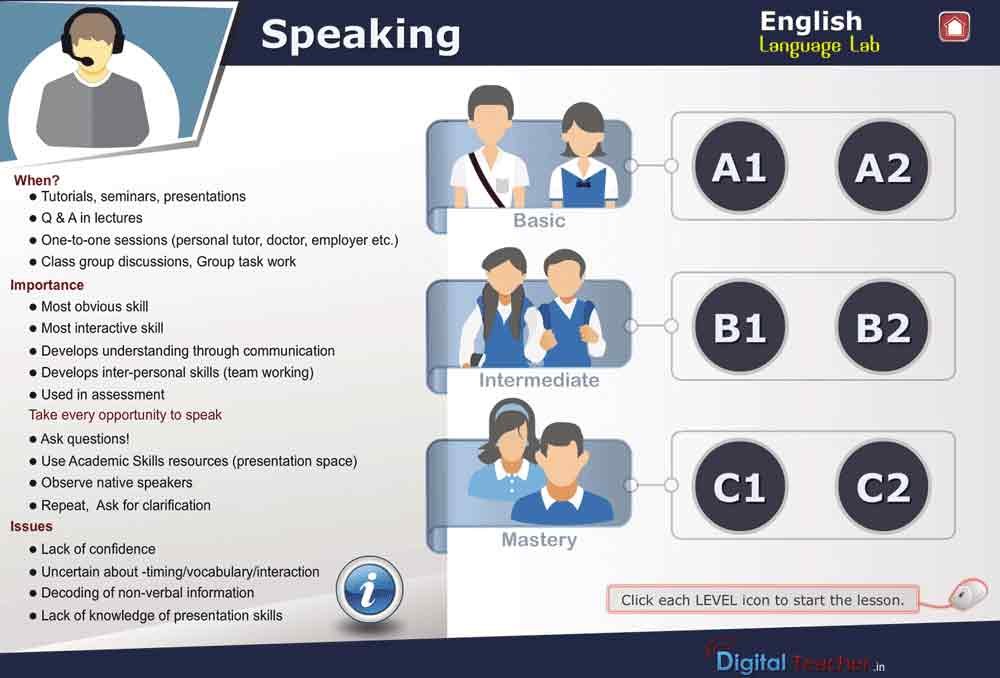
- Importance of Speaking Skills:
- Speaking is identified as a core skill required for effective communication.
- It is recognized as active, enhancing comprehension through direct communication.
- It highlights the importance of developing interpersonal skills such as teamwork.
- Sections and Activities:
- Our Software covers many levels of skill (A1, A2, B1, B2, C1, C2).
- Each level includes unique activities and challenges designed to improve your communication skills.
- Indicates that clicking on these subsections gives more details about what they include.
- Practice Words:
- Describes the “Practice Words” task in A1.
- Students listen to word pronunciations, record their own voice, and compare it to an expert’s pronunciation.
- Each word is marked using a phonetic symbol that aids pronunciation.
- Speaking on a Topic:
- Describes activities in which learners discuss certain subjects or scenarios.
- Exercises include self-introductions and conversational role-plays.
- These activities follow real-life speaking situations to improve practical communication skills.
- Recording and Feedback:
- This section explains how to record and provide feedback for spoken activities on the platform.
- After recording, students may listen to their own voices to evaluate pronunciation and understanding.
- Allows users to download recorded materials for personal evaluation or comments from teachers.
- Interactive Learning Platform
- Facilitates active engagement with spoken English exercises.
- Practice speaking through interactive prompts and activities.
- Improves fluency and comprehension.
These activities help you learn new terms and enhance your grasp of them. Learning English takes time and effort, but with dedication and practice, you can become a confident English learner.
Language Learning Activity-3: Reading Activities (R)
- Digital English Language Lab software aims to improve English reading skills. It includes components like reading comprehension, speed, fluency, and new vocabulary.
- The program helps users increase their knowledge and understanding of what they read, allowing them to read faster while still comprehending the information. It also enables students to develop real-life connections and make meaning of what they read.
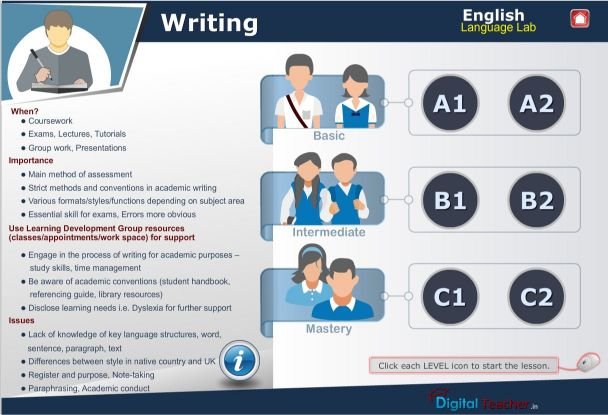
- Importance Levels of Reading:
- Reading is important for learning language structure and vocabulary.
- Helps to improve reading comprehension skills.
- Reading levels are categorized as A1, A2, B1, B2, C1, and C2, with increasing difficulty.
- Each level includes distinct units and activities.
- A2 Level Activities:
- Understanding simple present tense with regular actions.
- Assessment: At least 75% to progress to the next level.
- B1 Level Activities:
- Understanding and using modal verbs in different contexts.
- Matching modal verbs to appropriate usage.
- B2 Level Activities:
- Learning idiomatic expressions and their meanings.
- Matching idioms with correct definitions.
- C1 Level Activities:
- Reading comprehension and answering questions.
- Close Test filling in missing words.
- C2 Level Activities:
- Phrasal replacement and sentence completion.
- Interactive Learning Platform
- Facilitates active engagement with spoken English exercises.
- Practice speaking through interactive prompts and activities.
- Improves fluency and comprehension.
- Assessment:
- Regular assessments after each level to ensure understanding and progression.
Language Learning Activity-4: Writing Activities (W)
- Writing plays an important role in English because it demands plenty of skill sets, including word selection, sentence organization, and effective communication. Grammar, ideas, vocabulary, and structure are all fundamental elements of effective writing.
- The ability to write develops through planned assignments that take students from paragraph creation to essay writing, with an emphasis on creative order and fluency.
Level A1: Basic Writing Skills
- Missing Letters Unit:
- Fill in the blanks based on the images provided.
- Submit your answers to receive fast feedback.
- Odd Builder:
- Odd Builder allows users to solve crossword puzzles with picture clues.
- Submit completed puzzles for examination.
- Level B1 requires intermediate writing skills.
- Poster Designing:
- Learn how to create posters efficiently.
- Create posters for scientific fairs and school activities.
- Biography Writing:
- Understand about the development of biographical sketches.
- Write biographies based on the information provided about historical personality types.
Higher Levels: Advanced Writing Skills
- Graphical Interpretation (C1):
- Examine and summarize data from charts and graphs.
- Answer questions based on graphical data and receive fast feedback.
- Article Writing (C2):
- Create essays based on the guidelines and directions.
- Use the given words creatively to create connected paragraphs.
- Assessments and Feedback (Continuous Assessments)
- Assess understanding as well as use of skills in writing.
- Ensure that you are ready to go on to the next level.
- Structured writing activities enhance proficiency across levels.
- Develop critical thinking and communication skills essential for academic and professional contexts.
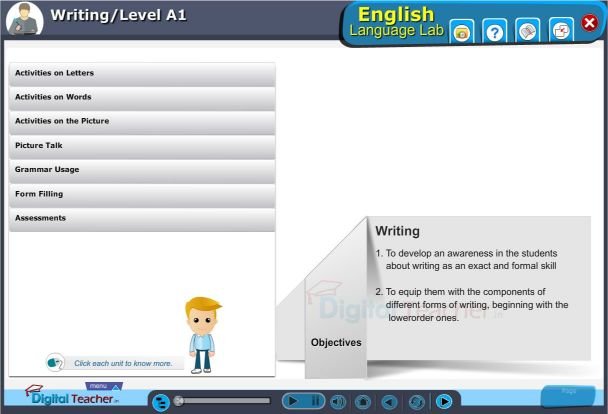
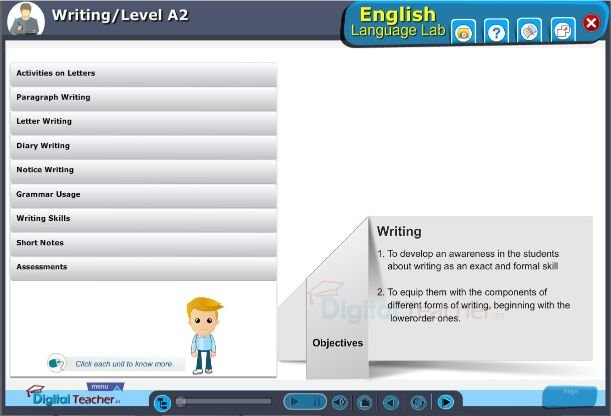
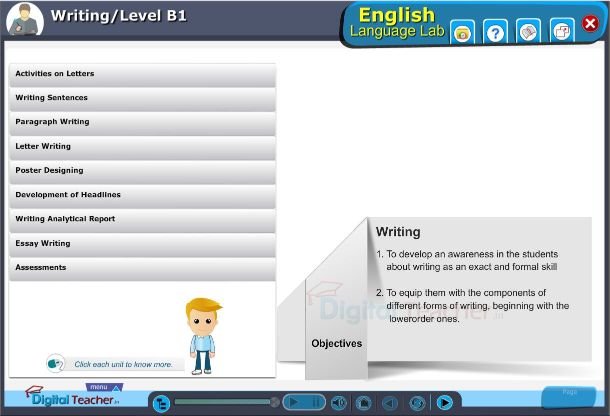

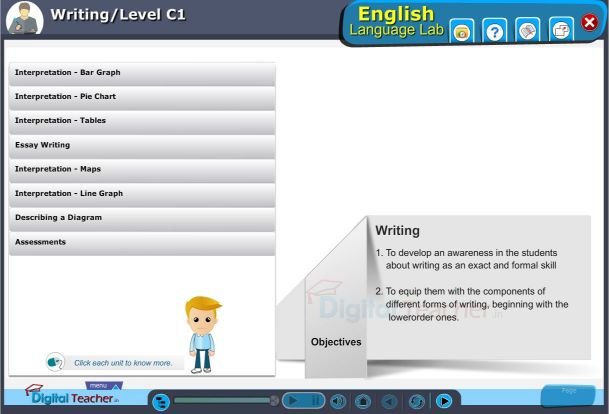
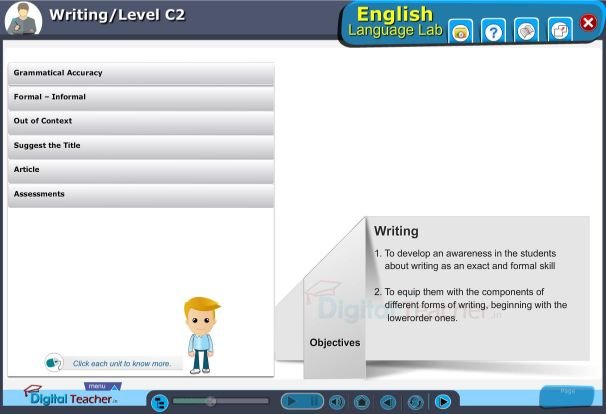
You may also see screenshots of our English Language Lab software, which includes (Level A1 to C2) Writing Skills activities, above. These screenshots clarify the interactive learning activities developed to help you improve your skills in writing.
Additional Features in Our Language Lab Software:
These additional exercises help students in schools and colleges enhance their understanding of spoken English as well as improve their grasp of the language.
English Grammar and Vocabulary Builder:
Learn more by expanding your vocabulary and improving your grammar with our Bonus Grammar and Vocabulary Tutorials. Taking part in interactive assessments and tasks that are meant to make learning entertaining as well as efficient.
- English Grammar: Essential for clear, powerful sentences.
- English grammar is essential for creating clear, attractive paragraphs.
- Language Laboratory software: Supports grammatical fears by showing errors such as subject-verb agreement, pronoun confusion, and tense changes.
- Vocabulary is a toolkit for proper communication and creative thinking.
- Recording Technique: A unique method of communication that includes word selection, sentence construction, and tone choice.
- An understanding of language can be understood by writing that is clear, direct, and attractive.
- Helps in building a wide range of vocabulary suitable for different age groups.
Phonetics Activity & Skill Level – Unlocking Sounds
| Phonetics Activity | Unlocking Sounds in Level |
|---|---|
| Definition of Phonetics | Phonetics as the study of these diverse sounds, each symbolized by a unique phonetic symbol. |
| Exploring the Letter ‘A’ (Beginner) | The search of Letter ‘A’: Highlights pronunciation differences in terms such as “apple” and “actor.” |
| Examples of Different Sounds (Beginner) | Explore words like aeroplane, apple, artist, alarm, and around to grasp how one letter can produce an array of unique sounds. |
| Total Sounds (Intermediate) | Learned all 44 different sounds in English, despite only having 26 letters. |
| Objective (Intermediate) | Improves English pronunciation by studying phonetic symbols and sounds. |
| Motivation to learn (Intermediate) | Allow yourself to speak English fluently and clearly. |
Continue what you’ve learned by continuing to practice and enhance your phonetic comprehension, preparing the way for better English communication skills. To learn more about phonetics, visit this YouTube channel -

Importance of Life Skills & Soft Skills in Language Lab
| Life Skills | Soft Skills |
|---|---|
| Introduction and Importance: Life skills are fundamental characteristics that allow people to properly handle their everyday activities and problems. These are important for personal growth and achievement in various life situations. | Introduction and Importance: Soft skills are social talents that let people engage, communicate, and collaborate with others. They are necessary in both professional and personal situations for success and collaboration. |
| Examples: Include teamwork, communication, time management, and problem-solving. | Examples: A few examples are communication, leadership, empathy, and flexibility. Such skills are needed for developing relationships, solving problems, and managing interactions at work. |
| Benefits: Learning life skills boosts resilience, self-confidence, and flexibility in a variety of conditions. | Benefits: Soft skills improve employability, collaboration, and solving issues. They help people succeed in their careers and develop personally. |
| Level of Skill Development: Life skills use consistent practice and learning to perfect. They are required for personal development and a healthy lifestyle. | Level of Skill Development: Soft skills may be improved by instruction, work, and self-reflection. They change with personal development and can be improved throughout one’s professional life. |
I hope the above information helps you understand “Top Language Learning Activities in Digital Teacher Language Lab Software“!

Look into our software and syllabus PDF to understand how Digital Teacher may improve English language learning in colleges, schools, and individuals. Whether you’re a teacher or a student, our affordable, offline-accessible software provides an entire syllabus that includes LSRW skills, grammar, vocabulary, phonetics, and more.
Download the language lab syllabus PDF and discover the future of English language learning with Digital Teacher now!
Digital-English-Language-Lab-Software-Technical-Specifications Download


